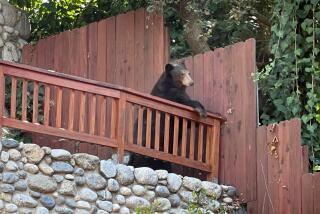The Call of the Wild Is a Plea for the Earth
- Share via
SAN DIEGO — It is early morning at the San Diego Zoo, before the tourists have started to arrive. Tatqiq, one of four polar bears here, is about to take her first dip of the day.
She waits and then dives -- surprisingly gracefully -- into the 55-degree water. Her big body shoots downward, white fur gleaming in refracted sunlight. She circles the bottom of the pool and then surfaces straight upward.
From behind the plexiglass at the Polar Bear Plunge observation area, Michael Kranz, 16, a junior at La Jolla High School, watches Tatqiq’s every move. For a moment, student and 450-pound subject are nose to nose.
Michael, a polite, earnest teenager who dreams of attending UC Davis to study zoology, has had a rare opportunity to study Ursus maritimus, not just at the zoo but in the “polar bear capital” of North America: the tiny Hudson Bay town of Churchill in the Canadian province of Manitoba.
The province is remote and vast, perfect for the roaming polar bear population. “It’s like Oklahoma times 10 -- with caribou,” Michael said.
Michael was one of nine high school students from Canada, the U.S., Europe and Australia who spent two weeks last month studying polar bears in their natural environment. The frozen-classroom Polar Bear Science Camp is organized by Polar Bears International, a nonprofit group based in Baton Rouge, La., which picked up the tab for Michael and the others.
Now in its second year, the polar bear program is slated to expand next year, with more students and more instructors.
Robert Buchanan, a former Seagram Co. marketing executive who is president of Polar Bears International, hopes the students will return as advocates for the fragile ecology of the Arctic.
“North Americans don’t realize what a tremendous resource we have in the Arctic,” Buchanan said in a telephone interview. “The polar bear is the icon of all Arctic animals.”
Polar Bears International has another plan to get the message out about the Arctic: live television broadcasts to selected zoos and school districts in which students act as hosts. “It’s simple: Bring sharp kids up here, let them see the beauty here, and they’ll become our ambassadors,” Buchanan said.
San Diego Zoo officials selected Michael for the polar-bear program on the basis of an essay and interview. “It’s time for us to be caretakers of the environment,” he said, “not just takers.”
Polar bear experts at Churchill tutored the teens on the habits and challenges of the species. By helicopter, they were taken to observe a “maternal den.” Students helped a researcher in a project designed to catalog the bears by their distinctive whisker patterns.
The “classroom” is a contraption called a “tundra-buggy,” essentially a bus-sized vehicle with cage wiring for safety. The polar bears may be beautiful, but they are also carnivores.
“They’re amazing creatures,” Michael said. “It’s amazing to see how happy they are, but you also have to realize they could bury their incisors 3 inches into your face.”
Hundreds of polar bears traipse through Churchill (pop. 1,000) each fall as ice begins to form in Hudson Bay. Their goal is to catch and devour blubber-rich seals. Churchill residents have learned that the bears have the right of way.
“It was a really bad place to build a town,” said JoAnne Simerson, senior polar bear keeper and the San Diego Zoo’s representative on a consortium of zoos formed to protect the species in the wild and enhance the captive population.
Although the polar bear is not an endangered species, it has shown some alarming changes in recent years, possibly because of global warming. Canadian Wildlife Service scientists have noticed that the bears look skinnier and less energetic than usual.
Still, the polar bears of Churchill are bigger than those at the zoo. In the wild, their seal-rich diets are thought to be about 90% fat as they put on blubber to withstand the long, cold winter.
In San Diego, where 60 degrees is considered chilly, the polar bears’ seal-free diet is about 10% fat. The biggest of the San Diego bears is Kalluk, a sub-adult male, at 750 pounds and growing. In the wild, it is not unusual for an adult male to be 1,500 pounds or more.
Polar bears are a social, playful lot, often grabbing their pals with a wide-open mouth. They roughhouse and sometimes swim in tandem. Keepers never stray within striking distance of the paws with the sharp claws; a similar rule about keeping a safe distance is observed in Churchill.
On this day, Tatqiq and Kalluk had first dibs on the 130,000-gallon pool at Polar Bear Plunge for swimming and stretching. Later it was time for females Chinook and Shikari.
At La Jolla High, Michael plays saxophone in the jazz band and is a member of the Key Club for high achievers. His father, Thomas, is a building contractor; his mother, Kathleen, is a piano teacher.
He said his interest in polar bears is not something that he shares with his fellow classmates. “It doesn’t come up in normal conversation,” he said.
But a chance to visit and study at Churchill was irresistible to someone who is torn between becoming a veterinarian or a wildlife writer for National Geographic. The collision between polar bears and people has to be managed to prevent the bears from being victimized by ecotourism run wild, Michael said.
“We’re the future, right?” he said. “So if we pass along these ideas to our children, the Earth will be a better place.”
More to Read
Sign up for The Wild
We’ll help you find the best places to hike, bike and run, as well as the perfect silent spots for meditation and yoga.
You may occasionally receive promotional content from the Los Angeles Times.






